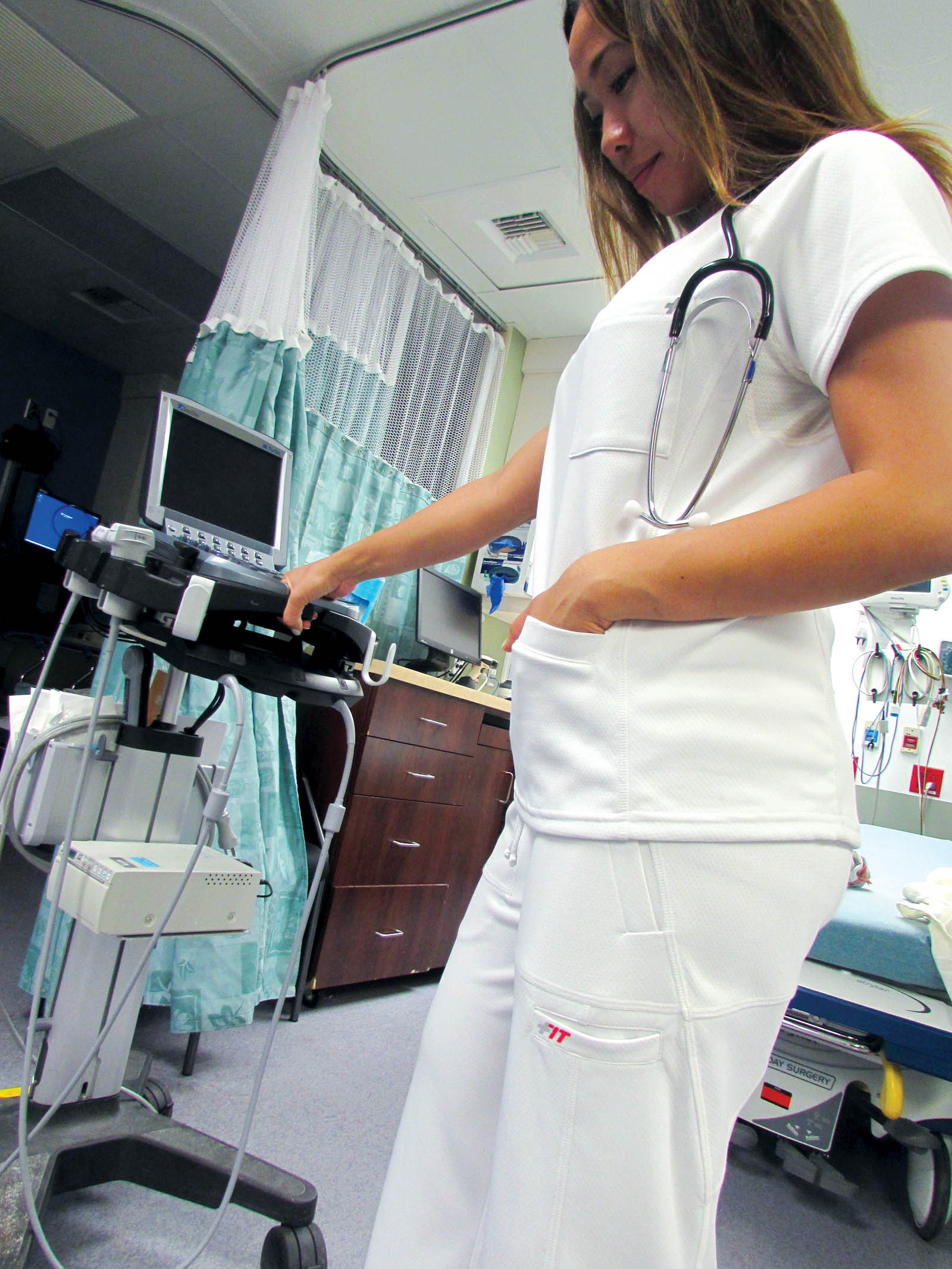
Textile manufacturers respond to the need for flexible medical and biomedical products

FIT Scrubs® uses silver-embedded yarn from PurThread Technologies Inc. to make antimicrobial scrubs for health care workers. Photo: ©PurThread Technologies Inc./Courtesy of FITScrubs.
In the world of bad news/good news scenarios, one can hardly find a more salient example than that presented in the medical arena. Technological advances are gaining traction amid the growing threats of superbugs, global spread of disease and demand for regenerative treatments to address the needs of aging populations. A Grand View Research Inc. analysis of the medical textiles market projects growth from $13.94 billion in 2014 to $20.23 billion by 2022.
Cases in point
According to the U.S. Bureau of Labor Statistics, health care is the most dangerous occupation in the country, says Marc Lessem, senior vice president of marketing for Vestagen Protective Technologies Inc. of Orlando, Fla.
“Health care workers are routinely exposed to microorganisms and body fluids capable of transmitting disease,” he says. “The origins of VESTEX® [protective garments] come from the realization that we have to take care of our health care workers in order for them to be able to provide superior care for their patients.”
Commercially launched in 2014, VESTEX was engineered with liquid repellency, breathability and antimicrobial properties. The proprietary chemistry and clinical study results allowed Vestagen to pursue FDA clearance as a Class II medical device, and the American Hospital Association (AHA) has issued an official endorsement for VESTEX (among AHA’s 32 endorsements, it is the only one for textiles).
“After one of our customers recognized the value of VESTEX for their health care workers, they asked us to design patient apparel, as they wanted to offer their patients that same level of protection,” Lessem says.

DuPont’s Tyvek® provides durability, breathability and a microbial barrier for sterile packaging of medical devices and drugs. Photo: DuPont.
McMurray Fabrics Inc. of Aberdeen, N.C., responded to a quite different need. With technical capabilities acquired over 20 years of manufacturing custom textiles for various industrial clients and the U.S. Department of Defense, the company began fielding requests from medical device manufacturers for custom implantable textiles. In 2001—a mere two years after the initial production of such components—the owners formed a stand-alone entity “to support the stringent requirements necessary to partake in this unique sector,” says Stephanie Norris, executive director of technology and product assurance for ATEX® Technologies Inc.
“Unmet clinical needs often are what prompt our involvement with new clients,” she states. “These customers are established public and private medical device companies, start-ups created by one doctor’s idea on a napkin, universities, and anything in between.”
With a Ph.D. in biomedical engineering, Kevin Nelson founded TissueGen® Inc. in 2000 to develop a fiber-based drug delivery system. In 2013, the Dallas, Texas-based company announced the commercial availability of its ELUTE® fiber.
The manufacturing process consists of three steps. The first step involves protecting the drug from the organic solvents typically required for wet extrusion. When manufacturing the polymer-based fibers, extrusion parameters can be varied to release the drug over a wide range of profiles tailored to therapeutic needs, explains Nelson, who serves as chief scientific officer. The final step prepares the fibers for use as a surgically implantable drug or perhaps as a wearable textile by removing residual solvents and preparing the fibers for sterilization and storage.
For more than 40 years, DuPont™ has been selling Tyvek® medical packaging for sterilized medical devices. In 2001, the company introduced a line of protective apparel for controlled environments in the manufacturing and dispensing of medical devices and pharmaceuticals.
Since September 2015, the Wilmington, Del.-headquartered company has been collaborating with Johns Hopkins University on a DuPont Tychem® garment to protect people during an infectious disease outbreak. Although DuPont will be responsible for commercialization, the university is aiding in the preparation of information for users.
“Some innovations are conceptually appealing but need further refinement prior to mass production,” says David Kee, North American marketing manager for Tyvek protective apparel.
Linking success

Arthur Lucero founded FIT Scrubs® to create garments that protect health care workers from the exposure risks of their occupation. Photo: ©PurThread Technologies Inc./Courtesy of FITScrubs.
Arthur Lucero, a former paramedic living in Los Angeles, Calif., has just reached the launching pad for a line of antimicrobial scrubs with silver-embedded yarn made by PurThread Technologies Inc., a company he found on materialconnexion.com and reached out to via LinkedIn.
PurThread creates antimicrobial staple fibers and continuous filament yarns for antimicrobial products ranging from mop heads to hospital scrubs. The Cary, N.C.-based company devised a proprietary process to embed Kodak’s EPA-registered silver salts into fibers at the molten stage of fiber production, and has optimized the process over years of research and development.
“There has been a generalized norm to create fashion-oriented scrubs that focus on colorful prints with a lighthearted approach,” says Lucero, who named his company FIT Scrubs®. “It has been a wholehearted collaborative effort by PurThread’s technical team, our fabric mill’s textile engineers, and my ability to express the particular wants and needs of the medical community for a functional uniform.”
“We provide antimicrobial fibers to his specifications, as well as quality assurance testing on his products,” says Scott Ballenger, PurThread’s senior vice president of business development. “We have collaborated along the way to help him achieve his goal.”
Vestagen works with experts and researchers who have developed many lifesaving products, Lessem says. “Their role is to provide guidance to our manufacturing and engineering teams.
“We are active in the retail partner, licensing and distribution securing process,” he continues. “We envision a number of licensing arrangements where manufacturers make their brand of scrubs but with VESTEX prominently noted. Remember ‘Intel Inside’? As we build the VESTEX brand, we will selectively partner with direct-to-consumer partners who have an established footprint in this space.”

TissueGen’s ELUTE® fiber loaded with pharmaceuticals is suited for woven, knitted or braided applications in implantable medical textile devices. Photo: TissueGen Technologies Inc.
“ATEX has identified several partners who contribute to its success,” Norris says. “They range from academic institutions to OEMs that we find through strategic initiatives. We work closely with them to ensure we understand each other’s expectations.”
TissueGen works with major U.S. medical textile companies; pharmaceutical, medical device and therapeutic companies; and government-funded entities “to develop novel treatments for medical applications,” Nelson says. “Each customer presents an opportunity to develop a new ELUTE fiber-based product. We have invested heavily this past year in qualified personnel and critical infrastructure to support expanded research, development and manufacturing capacity; product quality; and regulatory compliance.”
“The regulatory environment has intensified its focus on the medical device supply chain in an effort to better assess risk,” Norris says. “Reimbursement (the cost private payers and Centers for Medicare and Medicaid Services are willing to pay to cover medical procedures and devices) and factors such as increased regulation have brought new challenges in managing the cost of the components.
“ATEX emphasizes design for reliability and manufacturability. We follow a process that ensures a predetermined set of checkpoints is met before the project advances,” she adds. “We have a robust assessment program to identify risks early in the process. Vertical integration has reduced risk in the supply chain, but manufacturing medical-grade polyester is about quality and continuity of supply more than economic benefit. We will not sacrifice quality for cost.”

ATEX Technologies’ implantable textiles can be formulated into a dimensionally shaped tubular weave that allows the inner diameter to transition in size to align with a patient’s anatomy. This image shows a magnification of 100. Photo: ATEX Technologies Inc.
Moving forward
DuPont is developing a line of Tyvek cargo covers to protect pharmaceutical products during shipping. In April, it introduced Tyvek Xtreme™ W50, which features a layer of insulation that extends that protection against heat and cold.
PurThread is working with academic institutions to further study applications and benefits of incorporating its yarns across multiple fabrics. “We want to stay on the cutting edge of antimicrobial textiles,” Ballenger says.
The fact that ELUTE fiber can deliver pharmaceuticals and biologic agents at an implantation site to direct cellular and tissue growth “dramatically changes how medical textiles can be used, taking them from the current use of simply structural support to orchestrating the wound-healing process,” Nelson says. TissueGen is now in the trial stages of using ELUTE fiber for spinal cord repair.

ATEX Technologies’ implantable textiles in a plain weave construction provide durability while allowing tissue integration.
This image shows a magnification of 100. Photo: ATEX Technologies Inc.
“ATEX is committed to doing the right thing and investing in not only the technology to develop innovative device components, but also in infrastructure. Relationships and being involved in industry events help us better understand the future of our business and identify opportunities early,” Norris says. “We are contributing to devices that do not exist today with unique technologies, enabling new procedures and devices to address new and larger patient populations.
“It’s our intention to be diversified as the landscape changes and advancements in medicine evolve,” she continues. “Emerging technologies and new biomaterials will drive new products. A fresh direction is always on the horizon.”










